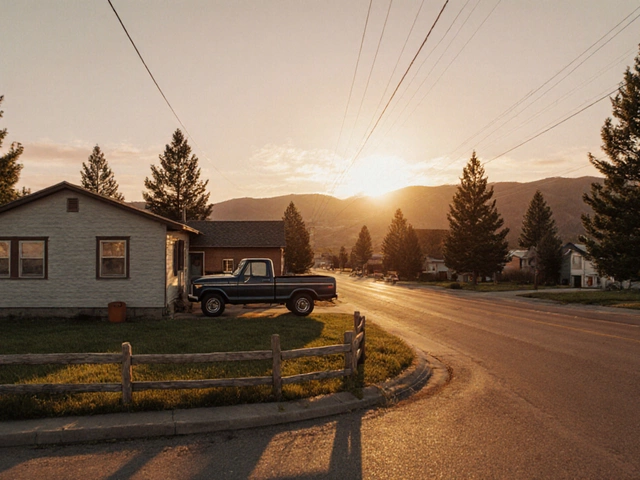If you’re poking around for commercial property, the cap rate is going to be one of the first things someone tosses your way. The number looks simple, but if you don’t know what it’s telling you, you could either overpay or walk away from something that could have made you a mint. Cap rate isn’t magic, but it is basically the speedometer for how fast your investment money could come back in the form of profit.
Think of cap rate as a quick gut-check. It tells you how much income you can expect from a property, compared to what you pay for it. Higher cap rate means the property could bring in more cash, but it might also spell more risk or an issue with the building or the neighborhood. If a deal sounds almost too easy—like a small office building with a double-digit cap rate in a city where everything safe is half that—you need to look twice. A lot of folks forget that a 'good' cap rate depends on the bigger picture, not just the number staring at you on a listing.
- Cap Rate—What It Is and Why You Should Care
- Typical Cap Rates and What Changes Them
- Location and Property Type: Big Factors
- Red Flags: When a 'Good' Cap Rate Isn’t Good
- Smart Tips for Evaluating Deals
Cap Rate—What It Is and Why You Should Care
Cap rate, short for capitalization rate, is just a formula. It measures how much money a commercial property can make you each year compared to its purchase price. So, if you see a place listed for $1 million with a yearly net income of $70,000, the cap rate is 7% (that’s $70,000 divided by $1 million). It lets you compare different properties on an even playing field, whether you’re looking at an office or a self-storage unit.
The real reason folks obsess over cap rates is that it’s the fast way to size up how risky or safe an investment seems. Lower cap rates usually pop up in big, stable markets like New York or San Francisco, where the risk of losing your investment is smaller—but so are your returns. Higher rates pop up where the chances of problems are bigger, like up-and-coming neighborhoods or older buildings that might need work.
Here’s why the cap rate matters: it helps you answer three big questions right away:
- Is the property priced fairly compared to others?
- Does the deal pay well enough for the risk?
- Can you get better returns somewhere else, like stocks or apartments?
Cap rate isn’t perfect—it ignores financing and taxes. But if you want a quick gut-check before getting buried in spreadsheets, this is your tool.
Typical Cap Rates and What Changes Them
Cap rates are all over the map depending on the year, the city, and what kind of building you’re eyeing. Right now, in 2025, most cap rate numbers for commercial stuff like office buildings, retail strips, and warehouses are hanging out between 4% and 8%. Prime downtown office properties in cities like New York or San Francisco might even drop closer to 3% because everybody wants in and the supply is tight. But if you look at something riskier—like a strip mall in a smaller town—don’t be shocked by rates above 8%.
Here’s a quick look at average cap rates in different types of properties in mid-2025:
| Property Type | Typical Cap Rate (2025) |
|---|---|
| Downtown Office | 3% - 5% |
| Suburban Office | 5% - 7% |
| Retail (Prime) | 4% - 6% |
| Retail (Neighborhood) | 6% - 8% |
| Industrial/Warehouse | 5% - 7% |
| Multi-family (Apartments) | 4% - 6% |
What makes these numbers jump around? For starters, interest rates play a huge role. When borrowing costs spike, investors want higher cap rates to make up for paying more on loans. Then there’s supply and demand—when everybody wants the same type of property, cap rates drop as buyers compete and push up prices.
Let’s not ignore property condition. A shiny, trouble-free building will usually clock a lower cap rate than a fixer-upper with roof leaks or problem tenants. Lease terms mess with it too. If a building has solid, long-term tenants paying market rent, you’ll see lower cap rates compared to places with empty units or short leases.
- Market location: Big cities, lower rates; smaller towns, higher rates.
- Property class: Class A (better condition/tenants), lower rates; Class C (more issues), higher rates.
- Tenant quality: National chains mean lower risk and lower rates; mom-and-pop shops bump the rates up.
- Economic health: Weak job or population growth in the area means investors want higher returns, so cap rates go up.
So, there’s no one 'perfect' number, but if you pin down what kind of property you’re after and where it is, you’ll get a clearer idea of what’s standard—and what might be too good (or too risky) to be true.

Location and Property Type: Big Factors
Not all commercial properties are built equal, and where they sit on the map makes a massive difference to the cap rate. For example, a retail strip in downtown Austin is probably going to have a much lower cap rate than a sleepy warehouse on the outskirts of Tulsa. Why? Investors trust prime markets more, and steady demand means steady rent. Lower risk means lower cap rate. On the flip side, if you see a higher cap rate, the location might be outside a hot zone or have more vacancies, so you’re likely taking on more risk for that bigger potential reward.
Let’s get into some real numbers. As of early 2025, the average cap rate for top-shelf office buildings in the heart of a big city hovers between 4.5% and 6%. Meanwhile, an older industrial property in a smaller city might spit out 7% to 9%. Medical offices and self-storage spots sit somewhere in the middle, usually in the 6% to 8% range, depending on how crowded the market is.
Think about the type of tenants too. National chains or medical groups with long, stable leases make a property less risky, usually leading to a lower cap rate. Small local shops or startups bring more risk, which means a higher cap rate to make it worthwhile for you as an investor.
Here are a few things that shape cap rates based on location and type:
- Urban vs. Suburban/Rural: Prime city spots mean lower cap rates, mostly because demand never really dries up. Suburban or rural areas see bigger swings.
- Property Type Matters: Retail, office buildings, apartments, warehouses—all have their own ‘normal’ cap rate range based on demand, lease length, and tenant security.
- Property Condition: A building that needs work often shows a higher cap rate. But you’ve got to factor in repair costs when doing the math.
If you’re comparing two cap rates, ask yourself—are they really comparable? Same city, same property type, same tenant mix? Otherwise, you’re not looking at apples-to-apples, and you might miss something big.
Red Flags: When a 'Good' Cap Rate Isn’t Good
Getting excited about a high cap rate? Hang on. Sometimes a number that looks amazing is just bait. Let’s break down where things can go sideways.
- Cap rate goes up when risk goes up. It might mean high vacancy rates or difficult tenants. Properties that sit empty longer usually offer higher returns on paper, but you eat those gains up with lost rent and maintenance.
- If the building’s in a declining area, that “great” cap rate probably won’t look so great when property values dip more. Sometimes, the only reason the rate is high is because buyers want more reward for rolling the dice.
- Short leases or big tenants about to leave? You’re exposed. One big tenant moving out on a 10,000 sq ft space can knock your returns below zero overnight.
- Don’t trust the numbers without digging into actual, recent rent rolls and expenses. Agents sometimes use “pro forma” (projected) rents or skip over hidden costs.
Check this out—a lot of investors forget to factor in real-life headaches:
| Pitfall | How It Hurts |
|---|---|
| High Cap Rate from Low Price | Cheap properties can have unseen issues (bad roof, unstable tenants, crime nearby). |
| Overestimated Income | Vacancies and late payments kill a deal fast. Always use actual, not projected income. |
| Ignoring Market Trends | Shifting industries, like remote work, can crush office demand even in good locations. |
And here’s a tip—compare cap rates for similar buildings in the same neighborhood, not just across the city or state. A good deal in one zip code could be a flop in the next, even if the numbers look alike. Crunch the real income versus real risk, and don’t skip walking the property yourself. Photos never show everything.

Smart Tips for Evaluating Deals
Before you jump in, you have to actually dig into the numbers behind the property—not just look at the cap rate and call it a day. Here are a few tips that help serious investors avoid newbie mistakes.
- Check Real Net Income: Don’t take the seller’s word for anything. Get the full rental income and maintenance costs yourself. Vacancy rates matter, too—if tenants are moving out every year, your income takes a hit.
- Verify Expenses: Account for insurance, taxes, utilities, regular repairs, and management costs. Sometimes expenses can be hidden or underestimated in the listing, leading to a cap rate that’s way too optimistic.
- Compare Apples to Apples: Look at cap rates for similar properties in the same area. For example, according to CBRE’s 2024 market report, office buildings in top US cities averaged cap rates around 6.2%, while smaller retail strip centers hit closer to 7.0%.
- Know the "Why": If a property’s cap rate seems way off what’s typical for the area, ask why. High cap rates often mean risk: location issues, old buildings, or uncertain tenant situations.
- Project the Future: Cap rate is only a snapshot. Check if there’s room for rent growth, if the neighborhood is on the up, or if some big lease is about to run out. Stuff can change fast, especially if you’re in a city with lots of new construction or shifting industries.
Here’s a quick look at how cap rates break down in 2024 for different commercial property types across the US. This gives you a real-world baseline:
| Property Type | Average Cap Rate (2024) |
|---|---|
| Multifamily (Apartments) | 5.0% - 6.5% |
| Office Buildings | 6.0% - 7.0% |
| Retail (Strip Centers) | 6.5% - 8.0% |
| Industrial/Warehouse | 5.0% - 6.2% |
Last thing: get your own inspector. Small issues can balloon into major costs, messing up your numbers and your profit. An extra $1,000 spent now can save you way more down the road. Don’t feel rushed—good deals happen all year, and the best ones come to buyers who pause and double-check everything.





